Ring my bell!
the god
of small things
of small things
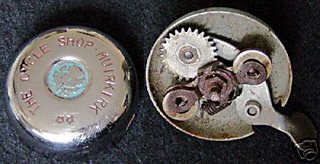 One of the best things about beaterbikes, especially if they're more than 30 years old, are the classic bells. This came to me today after that which rolls fell over, apparently putting my 2 1/2 inch bell out of commission. I really like it because there's an image of Saint Christopher on bell cover. What else would be better for protecting me while I travel the mean streets of Chicago?
One of the best things about beaterbikes, especially if they're more than 30 years old, are the classic bells. This came to me today after that which rolls fell over, apparently putting my 2 1/2 inch bell out of commission. I really like it because there's an image of Saint Christopher on bell cover. What else would be better for protecting me while I travel the mean streets of Chicago? It has much more character than the newer bells out there. The're typically cheap plastic and brass contraptions that break rather quickly. Being so inexpensive, you simply replace them. In contrast, my West German-made bell can take a lot of punishment. I screw off the top, remove the top bolt holding the clapper arm, and put the mechanism back in working order.
It has much more character than the newer bells out there. The're typically cheap plastic and brass contraptions that break rather quickly. Being so inexpensive, you simply replace them. In contrast, my West German-made bell can take a lot of punishment. I screw off the top, remove the top bolt holding the clapper arm, and put the mechanism back in working order.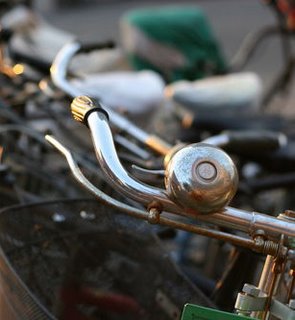 If you have an old-school bell like mine, go ahead and open it up sometime. The components of those models made before the mid 1970s are virtually indestructable. When they fail to sound, it's usually beacuse the cogs have shifted off their pinions or the mechanism is rusty. Once you've gotten them back in place, squirt on a small bit of graphite or other light lubricant to keep it running smoothly.
If you have an old-school bell like mine, go ahead and open it up sometime. The components of those models made before the mid 1970s are virtually indestructable. When they fail to sound, it's usually beacuse the cogs have shifted off their pinions or the mechanism is rusty. Once you've gotten them back in place, squirt on a small bit of graphite or other light lubricant to keep it running smoothly. Bells have been part of biking since the beginning. They were originally intended as a warning to pedestrians and horse-riders. Wandering peddlers used them to get the attention of their customers. I can remember a knife-sharperner who used to ride his bike into my neighborhood ringing his bell. It was like the one pictured here.
Bells have been part of biking since the beginning. They were originally intended as a warning to pedestrians and horse-riders. Wandering peddlers used them to get the attention of their customers. I can remember a knife-sharperner who used to ride his bike into my neighborhood ringing his bell. It was like the one pictured here.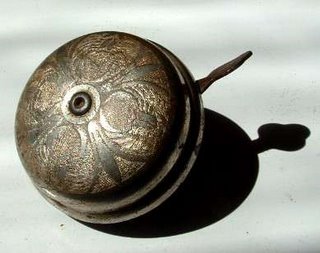 As increasing hordes of cagers made streets and roads more hazardous, manufactures responded with larger, handlebar-mounted bells. Not only were they louder. They also were sounded with your thumb or forefinger so you could keep your hands on the grips.
As increasing hordes of cagers made streets and roads more hazardous, manufactures responded with larger, handlebar-mounted bells. Not only were they louder. They also were sounded with your thumb or forefinger so you could keep your hands on the grips. The basic mechanism hasn't changed much over the last 100 years. There are essentially two designs. The first, and most popular in the US, places the bell horizontally to the handbars, usually as close to the grips as possible. The other design, more popular in Asia and some parts of Europe, places the bell vertically to the handlebars.
The basic mechanism hasn't changed much over the last 100 years. There are essentially two designs. The first, and most popular in the US, places the bell horizontally to the handbars, usually as close to the grips as possible. The other design, more popular in Asia and some parts of Europe, places the bell vertically to the handlebars.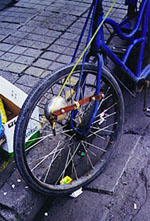 Other less popular designs are ingenious. This one, from a Chinese pedecab, is placed on the spokes of the front-wheel. The clapper in engaged with a long rod connected to the left grip. When the rider pulls it the clapper is thrust into the spokes causing the bell to vibrate rapidly. It sounds a lot like an old fashioned telephone ringing.
Other less popular designs are ingenious. This one, from a Chinese pedecab, is placed on the spokes of the front-wheel. The clapper in engaged with a long rod connected to the left grip. When the rider pulls it the clapper is thrust into the spokes causing the bell to vibrate rapidly. It sounds a lot like an old fashioned telephone ringing. Despite the lack of innovation in the mechanism itself, companies produced literally thousands of different cover designs. They included everything from abstract patterns to detailed images like skiers, comic characters, historical figures, as well as company logos or slogans.
Despite the lack of innovation in the mechanism itself, companies produced literally thousands of different cover designs. They included everything from abstract patterns to detailed images like skiers, comic characters, historical figures, as well as company logos or slogans.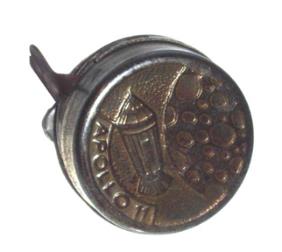 Schwinn produced a line commemorating extraordinary current events like the launch of NASA's Appolo 11, the first manned mission to land on the moon.
Schwinn produced a line commemorating extraordinary current events like the launch of NASA's Appolo 11, the first manned mission to land on the moon. Each is incredible when you see that the space typically available for the image is limited to a 2 or 3 inch circle. It reflects the specific attention to detail that manufacturers used to bring to every facet of bike design; even someting as insignificant as a bell.
Each is incredible when you see that the space typically available for the image is limited to a 2 or 3 inch circle. It reflects the specific attention to detail that manufacturers used to bring to every facet of bike design; even someting as insignificant as a bell.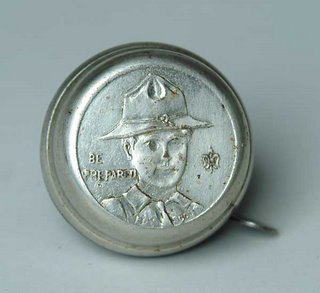 Today, manufacturers spend more time and effort on mass-producing electronic accessories and lycra clothing. It seems that the only way you can individualize your bike is to paint the frame or plaster it with political stickers.
Today, manufacturers spend more time and effort on mass-producing electronic accessories and lycra clothing. It seems that the only way you can individualize your bike is to paint the frame or plaster it with political stickers.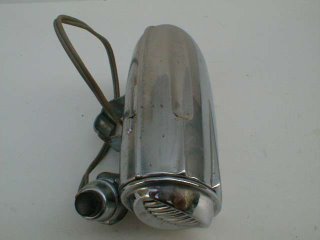 Or you can haunt the antique or used bike shops or hit Ebay. Most of the bells out there range in price from $7 to $25 depending on size, age, and condition. Again, you'll be amazed by the diversity of designs like this battery-operated bell from Japan.
Or you can haunt the antique or used bike shops or hit Ebay. Most of the bells out there range in price from $7 to $25 depending on size, age, and condition. Again, you'll be amazed by the diversity of designs like this battery-operated bell from Japan. Old-school bells aren't all that expensive when you consider that most new bells, which break after a year or so, start out at $10. Also, if one of your points for biking is to express individuality in a grossly conformist society, contemporary bells, no matter how colorful, are still mass-produced.
Old-school bells aren't all that expensive when you consider that most new bells, which break after a year or so, start out at $10. Also, if one of your points for biking is to express individuality in a grossly conformist society, contemporary bells, no matter how colorful, are still mass-produced. Then again, I have seen some cool ones out there. This brass bell from Amsterdam has the clapper on the outside. Its elegant bell cover reminds me of the onion domes I've see throughout Central Europe. Perhaps the designer was a homesick Slav?
Then again, I have seen some cool ones out there. This brass bell from Amsterdam has the clapper on the outside. Its elegant bell cover reminds me of the onion domes I've see throughout Central Europe. Perhaps the designer was a homesick Slav? Mirrycle produces what I think are some of the better contemporary bells, although it mostly sells the cheaper versions. This one lets you see the mechanism. Another, the Woodpecker, is made of wood - either Padauk or Japanese Cherry. Still, I don't know how these beauties would hold up in extreme weather.
Mirrycle produces what I think are some of the better contemporary bells, although it mostly sells the cheaper versions. This one lets you see the mechanism. Another, the Woodpecker, is made of wood - either Padauk or Japanese Cherry. Still, I don't know how these beauties would hold up in extreme weather. I may just be a nostalgic retro-freak; or maybe a tad too obsessive about seemingly trivial things. Ah hell, what's wrong with having a small piece of history artfully crafted and always reliable?
I may just be a nostalgic retro-freak; or maybe a tad too obsessive about seemingly trivial things. Ah hell, what's wrong with having a small piece of history artfully crafted and always reliable?Labels: Chicago, that which rolls, velopunk







1 Comments:
A bell with Saint Christopher on it?!!! I am extremely jealous. In all seriousness I've tried to find one with a mini statue of the virgin mary mounted atop. I may have to resort to making one.
Let me know if you come across one in your travels.
Post a Comment
<< Home